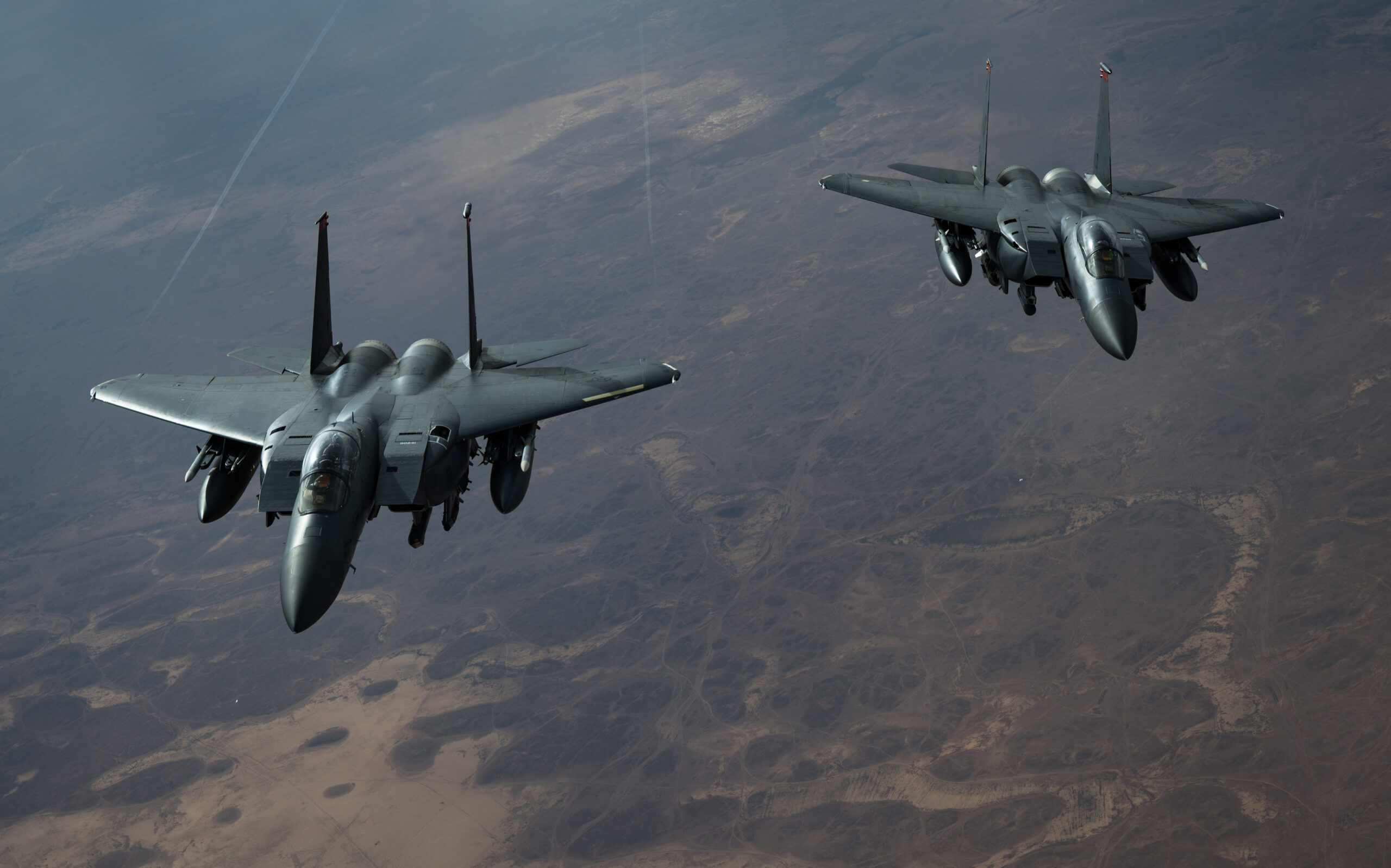

The U.S. military has launched an airstrike in Syria against a facility used by Iran’s Islamic Revolutionary Guard Corps, the second such operation within two weeks.
Two U.S. Air Force F-15s carried out the strike against a weapons storage site in eastern Syria, Defense Secretary Lloyd Austin announced on Wednesday.
“This precision self-defense strike is a response to a series of attacks against U.S. personnel in Iraq and Syria by IRGC-Quds Force affiliates,” Austin said in a statement. “The President has no higher priority than the safety of U.S. personnel, and he directed today’s action to make clear that the United States will defend itself, its personnel, and its interests.”
The F-15s used precision-guided munitions to strike a weapons storage facility used by Iran’s Islamic Revolutionary Guard Corps, or IRGC, in Maysulun, which is in Syria’s Deir ez-Zor region, a senior military told reporters on Wednesday.
“I watched the engagement and I can tell you that we’re pretty certain there were some secondary explosions that indicated that the facility was housing weapons that we believe are likely used in many of the strikes that have taken place against our forces here in the region,” the senior military official said during a press briefing.
Subscribe to Task & Purpose Today. Get the latest military news and culture in your inbox daily.
Wednesday’s airstrike comes amid a surge in attacks against U.S. troops in Iraq and Syria since Hamas launched its Oct. 7 terror attacks on Israel. American government officials have blamed the attacks on groups connected with Iran.

Between Oct. 7 and Nov. 7, American forces in Iraq and Syria came under rocket and drone attack 40 times, resulting in 46 U.S. troops being injured, according to the Pentagon. Twenty-Five of those service members were later diagnosed with Traumatic Brain Injury, or TBI.
Most of those attacks took place after the U.S. launched airstrikes in Syria on Oct. 26 against facilities used by the IRGC.
“By specifically targeting IRGC-associated facilities, we seek to convey a clear message to Iran that we hold it accountable for the attacks on U.S. forces, and we expect Iran to take measures to direct its proxies to stop,” a senior defense official told reporters on Wednesday.
However, the senior defense official conceded that the Oct. 26 airstrikes had failed to prevent further attacks against American forces in Iraq and Syria.
“There should be no question or doubt that President Biden, if he deems it necessary, will direct additional strikes to defend U.S. forces and interests,” the senior defense official said.
In a separate development on Wednesday, Houthi rebels shot down a U.S. MQ-9 Reaper drone off the coast of Yemen on Wednesday, a defense official confirmed.
No information about the circumstances of the incident was immediately available.
The senior military official declined to say whether U.S. forces may try to recover the MQ-9 Reaper that the Houthis shot down Wednesday over the Red Sea.
“We’re always concerned with where one of our aircraft goes down, and that’s of major importance to us,” the official said.
In June 2019, Iranian-backed Houthi rebels shot down a Reaper and tried to down another MQ-9 shortly afterward. That same month, Iran destroyed a $110 million Navy RQ-4 Global Hawk drone over the Strait of Hormuz.
More recently, the destroyer USS Carney also destroyed four cruise missiles and 15 drones launched by Houthi rebels on Oct. 18.
The last time the United States and Iran were this close to open hostilities was following the U.S. airstrike that killed Iranian Maj. Gen. Qasem Soleimani, the former head of the IRGC, Abu Mahdi al-Muhandis, the commander of Kata’ib Hezbollah, an Iranian-backed militia.
Iran responded shortly afterward by firing a barrage of ballistic missiles at U.S. troops in Iraq. More than 100 American service members at Al Asad Air Base in western Iraq were diagnosed with mild Traumatic Brain Injury following the attacks. Of those troops, 29 soldiers were awarded Purple Hearts.
UPDATE: 11/08/2023; this story was updated extensively following a press briefing with a senior military and senior defense official.
The latest on Task & Purpose
- Report: Special operations forces need to rethink language training
- US sends a warning with 2 aircraft carriers in the Mediterranean at the same time
- The Army’s 10 best scare badges, ranked
- Recon Marines will use electric dirt bikes on next deployment
- What it’s like to be stationed at Diego Garcia